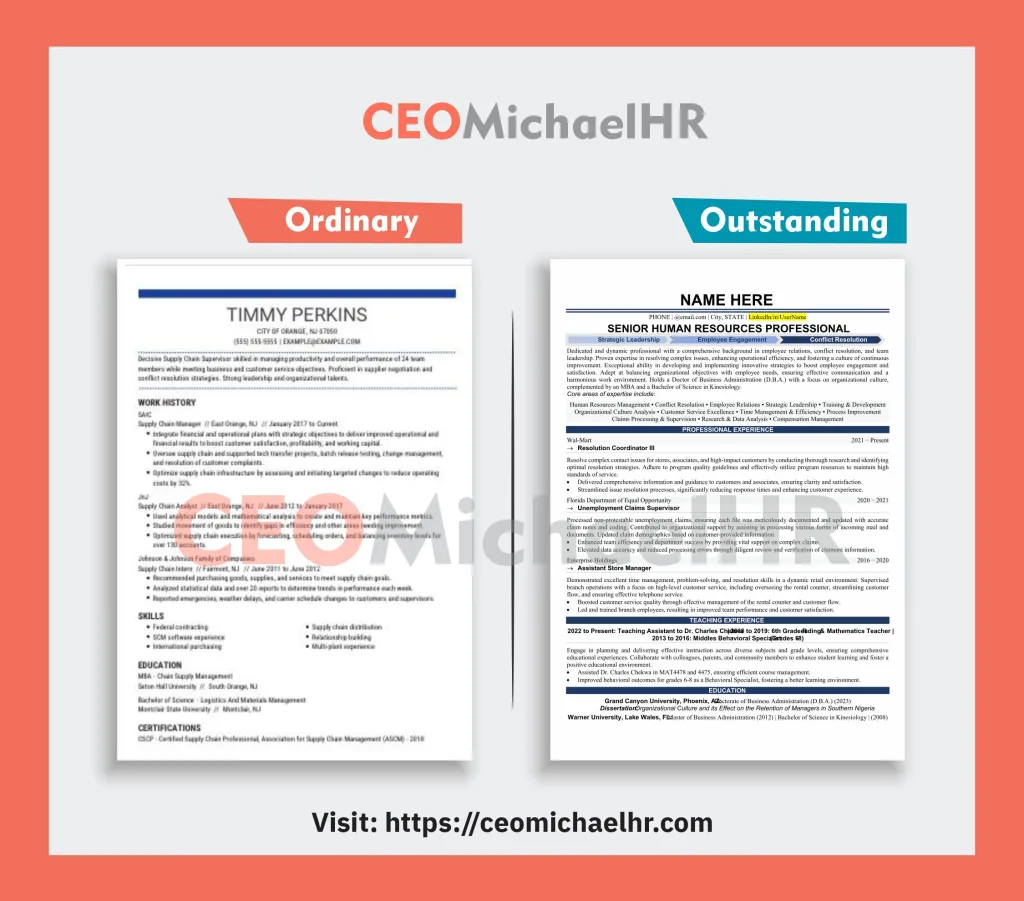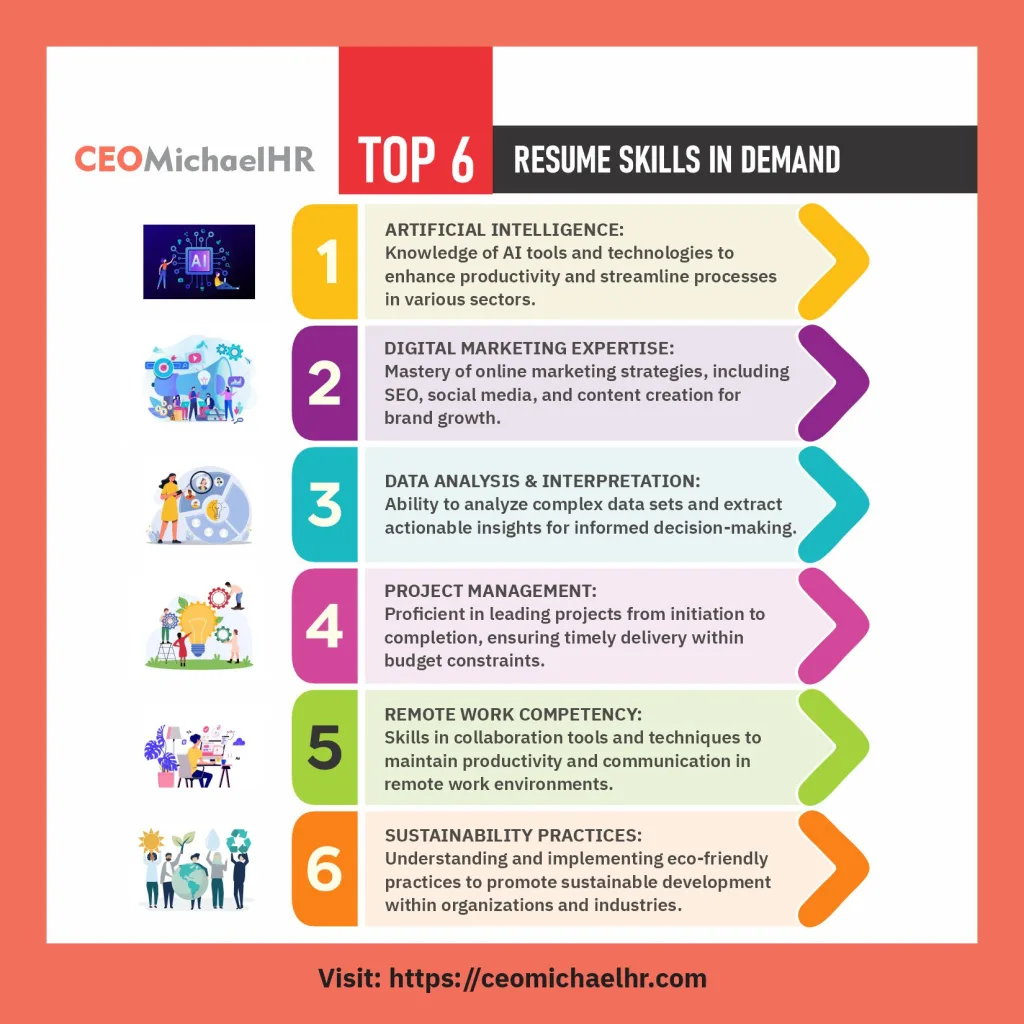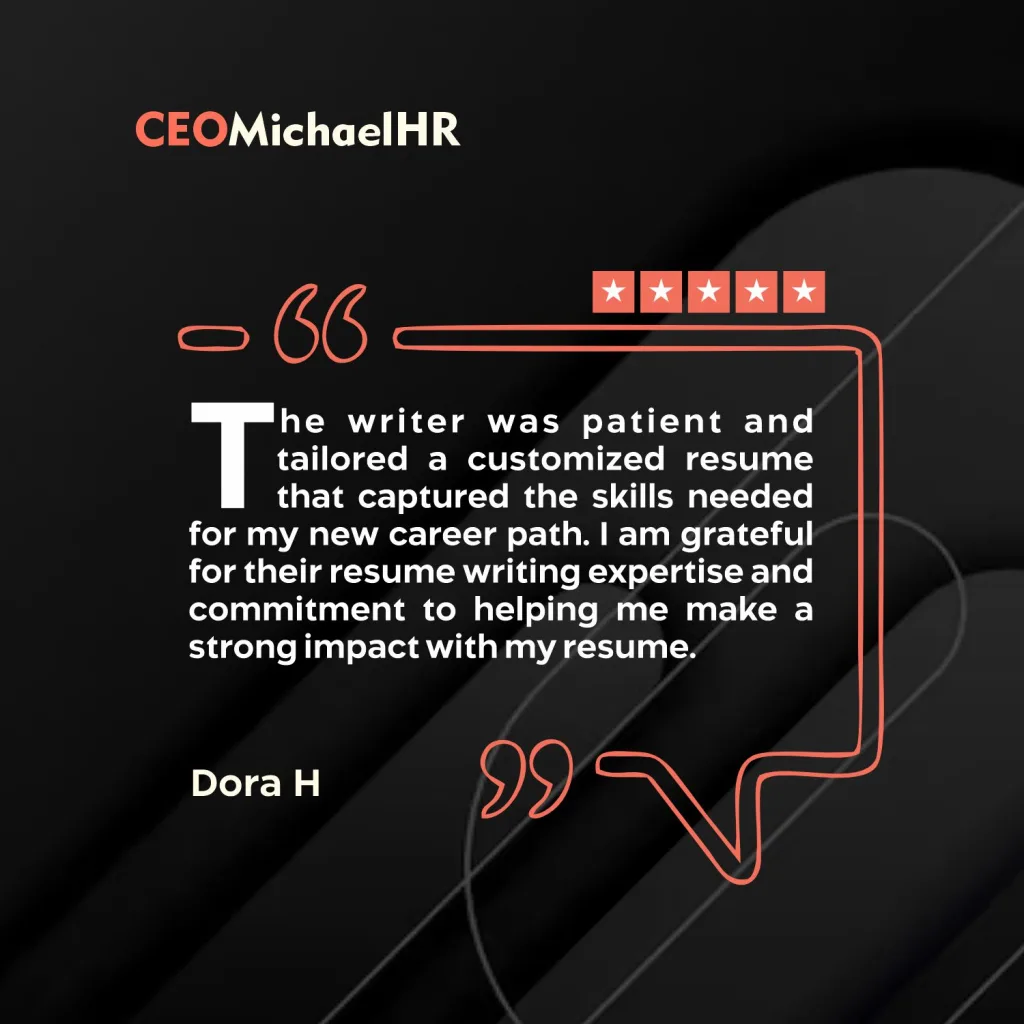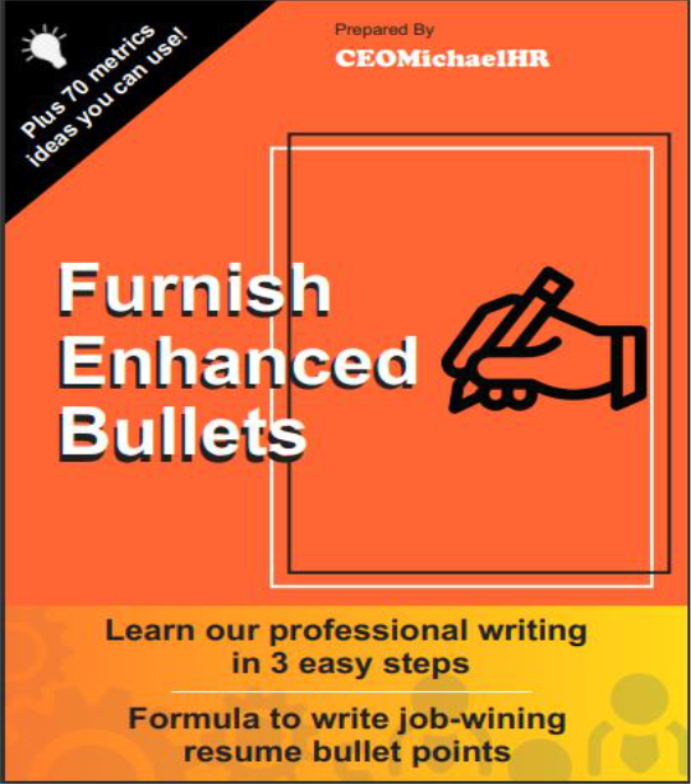
New clients, unlock 10% off all plans 🔥 at checkout with code: CEO10SPECIAL (Limited Time Offer)
New clients, unlock 10% off all plans 🔥 at checkout with code: CEO10SPECIAL (Limited Time Offer)






Imagine you’re preparing for a journey, but your map is outdated, missing key landmarks, and doesn’t reflect the best routes. Your resume is that map for employers, and in 2025, the terrain has changed dramatically.
The job market is more competitive than ever, with companies relying heavily on technology like Applicant Tracking Systems (ATS) to sift through candidates.
On top of that, the skills in demand today—like remote work proficiency, digital competency, and the ability to adapt to new technologies—are different from those of just a few years ago. A generic resume simply won’t cut it anymore.
To make 2025 your year, you need a resume that not only highlights your experience but also showcases your adaptability to today’s fast-changing job landscape.
The good news?
A few strategic updates can transform your resume into a powerful tool that grabs the attention of hiring managers and gets past even the toughest ATS filters.
In this comprehensive guide, we’ll walk you through six essential resume updates that will ensure your resume is standout, polished, relevant, and ready to make an impact in the new year.
With a keen focus on making these simple but effective changes, you’ll position yourself as a top contender for the roles you want.
So let’s dive into the 2025 resume trend and get your resume ready to shine incorporating these 6 effective resume updates.

Imagine you’re a hiring manager in 2025, tasked with sifting through hundreds of resumes.
Your eyes glaze over as you skim summary after summary filled with generic phrases like “hardworking professional” or “results-driven leader.” Then, suddenly, a headline catches your attention—“Innovative Supply Chain Executive Specializing in AI-Driven Solutions and Global Operations Efficiency.”
Immediately, you’re intrigued. You want to know more.
This is the power of a well-crafted resume headline in a highly competitive job market as today. Gone are the days when you needed to open with a lengthy summary that blends into the background.
In 2025, resume headlines are your opportunity to make a bold first impression—within just a few seconds.
Hiring managers spend an average of six seconds scanning a resume. The headline is like the subject line of an email—if it’s compelling, the reader digs deeper.
It acts as your personal branding statement, providing a snapshot of who you are and what you bring to the table.
Instead of wasting valuable space with overused phrases like “experienced professional,” your headline should highlight your most marketable skills or biggest achievements right at the top.
Think of it as your elevator pitch condensed into one sharp, memorable line.
To craft an effective resume headline, first think about what sets you apart. What’s your niche?
What value can you bring to the company you’re applying to? Keep it concise—one sentence or even a powerful phrase—and make sure it aligns with the job you’re targeting.
Here are a few standout examples for your 2025 resume update:
“Data-Driven Marketing Strategist with Expertise in AI and Predictive Analytics” – This headline signals a professional who’s not only skilled in marketing but also leverages cutting-edge technology to drive decisions.
“Operations Manager Known for Optimizing Processes and Reducing Costs by 25%” – Notice how this one focuses on measurable impact, immediately showing the candidate’s effectiveness.
“Bilingual Financial Analyst Specializing in ESG Investment Strategies” – This example highlights both a hard skill (bilingualism) and a trendy area of finance, making the candidate relevant to evolving industry needs.
When writing your resume headline, incorporate keywords that match the job descriptions of roles you’re pursuing.
In 2025, recruiters and Applicant Tracking Systems (ATS) will be looking for specific terms like “AI,” “digital transformation,” “sustainability,” or “remote team leadership.”
Using these terms will help your resume not only pass through ATS but also grab the attention of human recruiters who are scanning for specific competencies.
For example, if you’re applying for a marketing role, include keywords like “content strategy,” “data analytics,” or “SEO optimization.”
For a finance role, think about terms like “risk management,” “compliance,” or “financial forecasting.”
Aligning your headline with the language employers use can significantly boost your chances of getting noticed.
The resume headline is your shot to tell employers exactly why you’re their ideal candidate—and to do it fast.
In the fast-paced hiring environment of the new year, the difference between getting an interview or getting lost in the shuffle may come down to that single bold statement at the top of your resume.
Make it count.
With a strong focus on updating your resume headline, you’re not just keeping up with the trends—you’re setting yourself up for success.

Imagine you’ve spent hours crafting what you believe to be the perfect resume.
You’ve highlighted your experience, detailed your accomplishments, and even sprinkled in some buzzwords you’re sure will catch a recruiter’s eye.
Confidently, you hit ‘Submit’ on the job application, only to be met with radio silence. Days pass, weeks even, and nothing.
What happened? Chances are, your resume never even reached human eyes.
Welcome to the world of Applicant Tracking Systems (ATS).
In our fierce competitive job market today, nearly 75% of resumes are filtered out by ATS before they ever reach a hiring manager’s desk. These systems, designed to streamline the hiring process, scan resumes for specific keywords and formatting, separating the promising from the discarded.
And if your resume isn’t optimized for this digital gatekeeper? It’s as good as lost.
Let’s say you’re applying for a project management role. The job description lists key skills such as “budget management,” “team leadership,” and “Agile methodology.”
If these terms aren’t reflected in your resume—word for word—you risk being passed over.
But here’s the catch: you can’t just stuff your resume with keywords like a robot. ATS is smart, and hiring managers are even smarter.
Example:
Instead of simply listing “budget management” under your skills section, weave it into your experience.
“Managed and optimized project budgets of up to $1M, resulting in a 15% cost reduction over 12 months.”
Not only does this showcase your ability to manage a budget, but it also integrates the keyword in a way that feels authentic and impactful.
Now, you’ve created a sleek, visually stunning resume using colorful charts and elegant fonts.
You’re certain it stands out—until it hits the ATS and comes out the other side looking like a garbled mess of characters and misplaced text.
ATS is notoriously bad at handling creative layouts. What looks like a beautiful design to you may appear as hieroglyphics to the system.
Stick to simple, clean formats with clear section headings like “Work Experience,” “Skills,” and “Education.”
Bullet points, standard fonts (like Arial or Times New Roman), and consistent formatting are your best friends here.
Example:
Before ATS:
“• 🏆 Achieved a record-breaking sales increase 📈 of 30% in Q1 2024.”
After ATS:
“• Achieved a record-breaking sales increase of 30% in Q1 2024.”
Simple adjustments like removing emojis or special characters can ensure your achievements are read correctly by ATS—and passed along to the hiring manager.

One of the biggest mistakes jobseekers make is sending the same resume for every job application.
ATS systems are job-specific, meaning they scan for the exact skills and qualifications mentioned in the job description. If your resume doesn’t match, it’s unlikely to make it through the initial screening.
Imagine applying for two project management roles—one emphasizes team leadership, and the other focuses on Agile methodologies.
While both roles fall under project management, they prioritize different skill sets. Tailoring your resume to highlight team leadership for one role and Agile methodologies for the other can be the difference between rejection and an interview invite.
Example:
For a job that focuses on Agile, your resume might read:
“Led a cross-functional team of 10 in Agile sprint cycles, improving product delivery times by 20%.“
For a role that emphasizes leadership, the same experience can be rephrased as:
“Managed and led a team of 10, overseeing project delivery and enhancing team performance through effective leadership.“
Both descriptions showcase your experience, but each is tailored to align with the specific job requirements—boosting your chances of making it through the ATS filter.
In this new year, focus on optimizing your resume for ATS, and not just writing for a machine. Through incorporating this new year resume update tip, you’ll be paving the way for a hiring manager to see the real you.
Find out: Why you should never rely on ai to write your resume
Let me take you back to a conversation I had with a client named Josh.
Just last year, Josh was an operations manager at a mid-sized company, and like many professionals, his resume hadn’t seen an update in a couple of years.
He was confident in his abilities, but his resume wasn’t telling the right story—one that showcased the skills employers were actively seeking in today’s fast-paced job market.
We discussed extensively about how the landscape was changing. “Look,” I told him, “employers today don’t just want to know that you can do your job. They want to see that you’re future-ready.”
And what exactly does that mean?
It means highlighting the skills that are not only relevant today but also the ones that will shape the future workforce.

For instance, companies are increasingly adopting AI to streamline operations. I asked Josh if he’d had any experience with automation tools, and after some thought, he remembered how he’d led a project that introduced a new AI-based scheduling system.
“That’s gold,” I told him. We rewrote his resume to focus on how he not only managed the process but also saved the company 20% in operational costs by reducing scheduling errors.
In 2025, skills like AI proficiency, even if you’re not an engineer, can set you apart.
Whether you’ve used AI to make better decisions or automate routine tasks, these are the types of skills that can take a basic resume and turn it into a powerful story of adaptability.
Another skill that’s skyrocketing in importance is sustainability. Companies across industries are facing increased pressure to operate in environmentally responsible ways.
When I asked Josh if his company had any sustainability initiatives, he recalled overseeing a waste reduction project.
While he hadn’t thought it was relevant, we turned it into a powerful bullet point about how he reduced the company’s environmental footprint by implementing green practices, saving both money and resources.
Whether you’re in operations, marketing, or finance, sustainability is becoming a universal skill. It’s about demonstrating that you understand how your work can contribute to larger, global goals—something hiring managers love to see in the new year.
But it’s not all about technical skills. Employers are also hungry for adaptability and leadership in today’s hybrid and remote work environments.
I asked Josh how his team adapted to working remotely during the pandemic.
He hadn’t thought much of it—“We just got on with things,” he said—but after digging deeper, we uncovered that he had implemented a new project management system that kept his team of 15 engaged and productive, despite the challenges of remote work.
In 2025, these soft skills are just as critical.
Employers want to know that you can lead teams through change, work across different environments, and still achieve results.
So, whether you’ve managed remote teams, navigated digital transformation, or simply embraced new ways of working, make sure those stories are front and center on your resume.
The key lesson Josh learned—and one you should remember—is that the most effective resumes are tailored to each job you’re applying for.
For example, when Josh applied for a role in a tech-forward company, we focused heavily on his experience with automation and AI. For a different position in a company known for its environmental initiatives, we played up his sustainability projects.
2025 isn’t about listing every skill you have—it’s about selecting the ones that align with where the industry is heading.
Whether you’re an entry level professional, mid-level or senior executive, every role you’re applying for will have its own unique set of demands, and it’s your job to showcase that you’re ready to meet them head-on.
In the end, Josh’s resume wasn’t just a list of responsibilities. It became a compelling narrative about how he was embracing the skills of the future, positioning himself as a candidate who wasn’t just keeping up, but leading the charge into 2025.
So, what are the key skills you’re showcasing in your resume? Think carefully, because those skills could be the difference between landing the job and getting left behind.

Let’s say you’re a hiring manager with a stack of resumes on your desk.
As you sift through them, one stands out. It’s not the design or the length that grabs your attention—it’s the numbers.
Instead of vague statements like “Responsible for managing projects,” this resume says, “Led 5 cross-functional teams to deliver a $2M project 3 months ahead of schedule.”
Instantly, you can picture the candidate’s contribution and impact. That’s the power of quantifying your achievements when updating your resume for the new year.
In 2025, more than ever, hiring managers want to see results, not just responsibilities.
Think about it: which sounds more compelling?
“Improved customer service processes“
vs.
“Streamlined customer service operations, reducing response time by 35% and increasing customer satisfaction scores by 20%.“
The second example paints a clear picture of success—it’s specific, measurable, and gives the employer a glimpse of what you could potentially bring to their organization.
It’s easy to fall into the trap of listing tasks on your resume.
After all, you did those things, right?
But what really makes you stand out is how well you did them. Here’s where you need to think like a storyteller—what challenges did you face? What actions did you take? And what was the outcome?
Take this example from a mid-level marketing manager:
Before: “Managed social media channels and content creation.”
After: “Led social media strategy, growing Instagram following by 15K in 6 months, resulting in a 25% increase in inbound leads.”
The difference is striking. Instead of simply stating the responsibility, the revised version shows how the candidate drove growth through their efforts.
It makes you want to know more—how did they achieve that growth?
While it’s easier to measure hard skills like sales targets or cost reductions, don’t shy away from quantifying softer skills.
For example, if you’re a team leader, don’t just say you “managed a team.” Show how your leadership impacted the team.
Before: “Led a team of 10 customer service representatives.”
After: “Managed a team of 10 customer service representatives, improving team performance and achieving a 90% resolution rate within 24 hours.”
It’s not just about the size of your team—it’s about how well you managed them and what your management style helped the team accomplish.
Did your leadership result in faster problem resolution? Better morale? Higher customer satisfaction? Quantify it!
If you’re not sure where to start, think about three key metrics: percentages, dollar amounts, and timeframes.
Did you cut costs? By how much? Did you increase revenue? How much, and in what period? Did you finish a project early?
Quantifying even the smallest improvements can show prospective employers that you’re not just doing the job—you’re adding value.
For instance, consider this for a financial analyst:
Before: “Prepared financial reports and analyzed market trends.”
After: “Generated detailed financial reports that identified cost-saving opportunities, cutting departmental expenses by 12% in 2024.”
Now the hiring manager knows exactly how your financial analysis helped the company save money. It’s not just a task, it’s a measurable contribution.
Ultimately, the goal is to make your resume tell a story of success, with numbers serving as the proof.
Every percentage, dollar figure, and timeframe is a chapter in the story of how you transformed a task into a tangible achievement.
In 2025, this level of detail will be what separates you from the competition. So, think about your past roles, dig into the data, and let your numbers do the talking.
Find out: Our bio writing services for all industries and career levels
The world of work has changed dramatically in recent years, and 2025 is no exception. Hybrid and fully remote roles are no longer novelties—they’re the norm in many industries.
If your resume doesn’t reflect your ability to thrive in this environment, you could be missing out on some incredible opportunities.
Let me tell you about Jane. In early 2020, like many others, Jane found herself transitioning from a traditional office setting to working remotely.
At first, it was a challenge. Managing her time, staying connected with her team, and keeping projects on track felt like juggling too many balls at once.
But after a few months, Jane mastered the art of remote work, becoming a pro at using tools like Zoom for team meetings, Slack for quick communications, and Trello to organize her tasks.
When she decided to seek a new role in 2022, she didn’t just list her job responsibilities on her resume. She highlighted her remote work experience front and center:
“Successfully led a cross-functional team of 15 remotely, using project management tools such as Trello, Zoom, and Slack to ensure seamless collaboration and project delivery.”
Fast forward to 2025, and that decision paid off.
Jane was hired for a leadership position at a fully remote company, partly because she demonstrated that she could not only survive but thrive in a remote work environment.
Employers weren’t just looking for people who could manage tasks; they wanted candidates who could excel with minimal supervision while handling virtual communications and digital tools effortlessly.
So, how can you make your own story shine like Jane’s?
Highlight Remote Work Experience: If you’ve worked remotely, even part-time or during a pandemic, make sure it’s prominent in your resume. Don’t just say “worked remotely”—talk about the tools you used and how you stayed productive. Did you lead a virtual team? Meet tight deadlines despite being miles apart? That’s gold for today’s employers.
Showcase Tools and Platforms You’ve Mastered: Are you an expert in platforms like Asana, Zoom, Microsoft Teams, or Slack? Include these in your resume’s skill section. For example, you could say: “Proficient in remote communication and project management tools, including Zoom, Microsoft Teams, and Monday.com.”
Highlight Self-Management Skills: Employers know that remote work requires a certain level of discipline. Were you trusted with more responsibility while working remotely? Did you improve your time management skills? Perhaps you can say something like: “Independently managed a project from start to finish, coordinating across departments and time zones.”
A story of remote work success is not just about the job—it’s about adaptability.
Let’s take another example: Raj, a graphic designer.
Before the shift to remote work, Raj always worked in an office. But as more companies embraced hybrid work models, he found himself navigating new challenges—like how to deliver creative work without daily face-to-face meetings.
He quickly adapted, using design collaboration tools like Figma and Miro, and maintained regular virtual check-ins with his team.
When Raj applied for a new role, he didn’t bury his remote work story in the fine print. Instead, he emphasized how he streamlined design processes, reducing turnaround times by 30% while working from home:
“Implemented collaborative design tools such as Figma, enabling faster feedback loops and reducing project delivery times by 30% in a fully remote environment.”
His emphasis on adaptability and digital competency made him stand out from the crowd, showing that he wasn’t just following the trend—he was thriving in it. And that’s exactly what you should aim to do when updating your resume in 2025.
In a world where remote work is here to stay, demonstrating your digital competency could be the key to unlocking your next big career move.
Just as Jane and Raj adapted, you can show prospective employers that you have the skills to succeed, no matter where you work from.

Find out: more of our customer’s success stories
Picture this: an employer has just opened your resume. They’re sipping their coffee, half-focused, scrolling through dozens of applications that all look the same.
Then, they come across your resume—clean, professional, and visually striking. In a split second, you’ve already made a lasting impression, before they’ve even read a word.
The Design Trap
Most job seekers focus on the words in their resume, but what if the layout and design are what truly set you apart?
Think of it like a book cover—sure, content matters, but people are drawn in by visual appeal.
A cluttered, outdated resume layout can cause a hiring manager to overlook even the most qualified candidates.
Take, for example, Jason. He was applying for a marketing role, and his resume was filled with impressive achievements—yet he wasn’t getting any callbacks.
Why?
His resume was dense, hard to navigate, and, frankly, forgettable.
After a simple redesign—switching to a modern layout with clear sections, a fresh font, and some well-placed whitespace—Jason’s resume suddenly stood out.
He received three interview invitations within the first week of updating it.
Creating Balance with Whitespace
Whitespace is like the unsung hero of modern design. It gives the reader’s eyes a break and makes your accomplishments more digestible.
Imagine walking into a room crammed with furniture versus a room with minimal, well-placed pieces.
The second room feels welcoming, doesn’t it?
That’s what whitespace does for your resume. It signals professionalism and makes key points pop off the page.
Font and Visual Hierarchy
The font you use is just as important.
Forget Times New Roman or Arial—2025 is about clean, modern fonts like Calibri, Helvetica, or Georgia. These fonts exude professionalism without looking outdated.
Even better, they are easy to read on screens, which is essential as hiring managers increasingly review resumes digitally.
When Rachel was applying for a project management role, her old resume felt like a word-heavy thesis paper. By simply switching to a sleeker font and adjusting her headers to a slightly larger size, she created a strong visual hierarchy.
This allowed recruiters to quickly identify key sections like “Skills,” “Experience,” and “Education,” making her resume easier to navigate.
Subtle Use of Color
In 2025, color can also work in your favor, as long as you use it with intention.
A subtle splash—maybe a muted blue for section headers or a bold line under your name—can make your resume visually appealing without looking over the top.
But tread carefully. Too much color can distract from the content, while just the right amount can add personality and polish.
Think of it like what designers often say: “Less is more.” A pop of color, like a minimalist frame, can draw attention to what matters most—your skills and experience.
Resume Templates: A Shortcut to Success
If design isn’t your strong suit, there’s no need to worry. Templates have come a long way, and 2025 offers an array of sleek, professional designs that you can easily customize.
Sites like Canva, Adobe Spark, or even Google Docs offer ready-made resume templates designed by professionals. For those looking to save time while making a lasting visual impression, these templates can be game-changers.
Consistency
No matter which design elements you choose, consistency is key. Your font sizes should align, the spacing between sections should be even, and bullet points should be styled the same throughout.
This attention to detail can reflect your overall professionalism and the care you put into your work.
Refreshing your resume’s design and layout might seem like a small step, but it’s a game-changing move in 2025’s competitive job market.
With a modern font, strategic whitespace, and a touch of color, your resume can transform from just another document to an eye-catching story of your career journey.
…And in a world where first impressions happen in the blink of an eye, that’s exactly the edge you need.
Incorporating these six resume updates can give you a competitive edge in 2025’s fast-paced job market. Whether you’re seeking a new role or aiming for a promotion, these tweaks can make a powerful impact.
If updating your resume feels overwhelming, let CEOMichaelHR do the heavy lifting! Our expert resume writers craft tailored, ATS-friendly resumes that highlight your unique strengths and achievements. Don’t leave your career to chance—invest in a professionally written resume today and step into the new year with confidence. Visit CEOMichaelHR to start transforming your resume and boost your chances of landing your dream job!
Share
Further Reading
*The names and logos of the companies referred to in this page are all trademarks of their respective holders. Unless specifically stated otherwise, such references are not intended to imply any affiliation or association with CEOMichaelHR.
Land interviews 3x faster while submitting fewer resumes
Copyright © 2025, ceomichaelhr.com.
All rights reserved.
Land interviews 3x faster while submitting fewer resumes
Copyright © 2025, ceomichaelhr.com.
All rights reserved.

Learn the same techniques our expert resume writers have used to get thousands of clients closer to their next job
Unlock expert resume tips, start landing multiple interviews!

Stay connected to receive powerful career insights, updates, and inspiration that’ll help you hit your career goals.